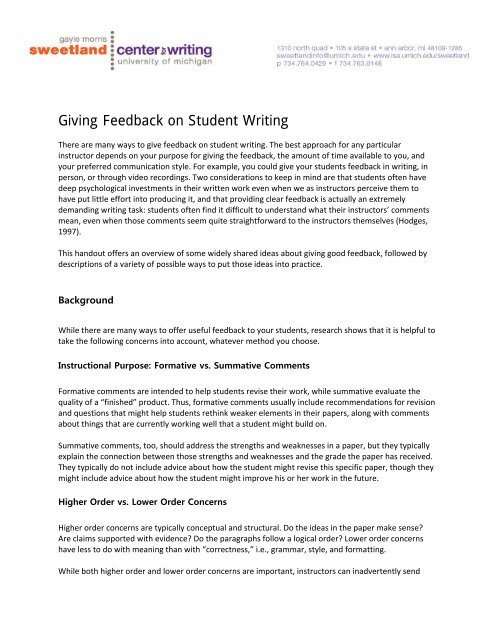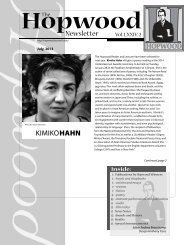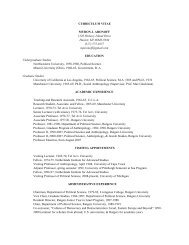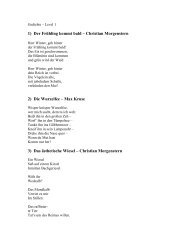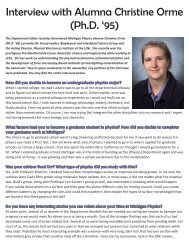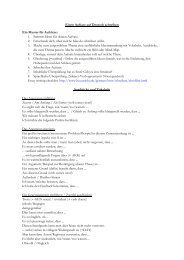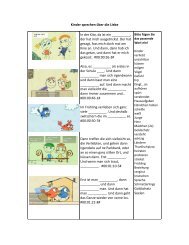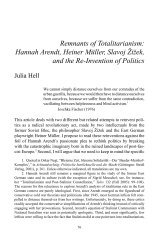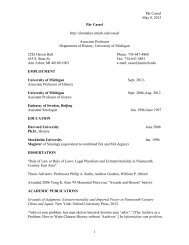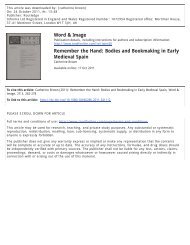Giving Feedback on Student Writing
Giving Feedback on Student Writing
Giving Feedback on Student Writing
You also want an ePaper? Increase the reach of your titles
YUMPU automatically turns print PDFs into web optimized ePapers that Google loves.
<str<strong>on</strong>g>Giving</str<strong>on</strong>g> <str<strong>on</strong>g>Feedback</str<strong>on</strong>g> <strong>on</strong> <strong>Student</strong> <strong>Writing</strong><br />
There are many ways to give feedback <strong>on</strong> student writing. The best approach for any particular<br />
instructor depends <strong>on</strong> your purpose for giving the feedback, the amount of time available to you, and<br />
your preferred communicati<strong>on</strong> style. For example, you could give your students feedback in writing, in<br />
pers<strong>on</strong>, or through video recordings. Two c<strong>on</strong>siderati<strong>on</strong>s to keep in mind are that students often have<br />
deep psychological investments in their written work even when we as instructors perceive them to<br />
have put little effort into producing it, and that providing clear feedback is actually an extremely<br />
demanding writing task: students often find it difficult to understand what their instructors’ comments<br />
mean, even when those comments seem quite straightforward to the instructors themselves (Hodges,<br />
1997).<br />
This handout offers an overview of some widely shared ideas about giving good feedback, followed by<br />
descripti<strong>on</strong>s of a variety of possible ways to put those ideas into practice.<br />
Background<br />
While there are many ways to offer useful feedback to your students, research shows that it is helpful to<br />
take the following c<strong>on</strong>cerns into account, whatever method you choose.<br />
Instructi<strong>on</strong>al Purpose: Formative vs. Summative Comments<br />
Formative comments are intended to help students revise their work, while summative evaluate the<br />
quality of a “finished” product. Thus, formative comments usually include recommendati<strong>on</strong>s for revisi<strong>on</strong><br />
and questi<strong>on</strong>s that might help students rethink weaker elements in their papers, al<strong>on</strong>g with comments<br />
about things that are currently working well that a student might build <strong>on</strong>.<br />
Summative comments, too, should address the strengths and weaknesses in a paper, but they typically<br />
explain the c<strong>on</strong>necti<strong>on</strong> between those strengths and weaknesses and the grade the paper has received.<br />
They typically do not include advice about how the student might revise this specific paper, though they<br />
might include advice about how the student might improve his or her work in the future.<br />
Higher Order vs. Lower Order C<strong>on</strong>cerns<br />
Higher order c<strong>on</strong>cerns are typically c<strong>on</strong>ceptual and structural. Do the ideas in the paper make sense?<br />
Are claims supported with evidence? Do the paragraphs follow a logical order? Lower order c<strong>on</strong>cerns<br />
have less to do with meaning than with “correctness,” i.e., grammar, style, and formatting.<br />
While both higher order and lower order c<strong>on</strong>cerns are important, instructors can inadvertently send
c<strong>on</strong>tradictory messages when they try to address both at the same time. For example, questi<strong>on</strong>s and<br />
comments that suggest that a paragraph needs to be entirely rethought and rewritten c<strong>on</strong>flict with<br />
sentence-level markups that suggest that the sentences already present in the paragraphs will remain<br />
where they are <strong>on</strong>ce they are cleaned up (Sommers, 1982).<br />
Drawing C<strong>on</strong>necti<strong>on</strong>s Between the “Big Picture” and the Details<br />
One comm<strong>on</strong> approach to commenting <strong>on</strong> student work is to offer praise, criticism, and questi<strong>on</strong>s in the<br />
margins of a paper, and to provide a more general overview of what the paper does well and what it<br />
does poorly. Ideally, this method should allow students to understand not <strong>on</strong>ly what the paper’s<br />
strengths and weaknesses are, but also where specific examples of these occur in the text. However, it<br />
can be surprisingly difficult for students to understand the c<strong>on</strong>necti<strong>on</strong>s between overview comments<br />
and marginal comments unless an instructor spells those c<strong>on</strong>necti<strong>on</strong>s out explicitly (Hodges, 1997). For<br />
example, an instructor might ask questi<strong>on</strong>s in the margins that indicate the need for evidence to support<br />
key claims, and might explain in his or her end comment that the paper’s greatest weakness is its failure<br />
to provide evidence. Yet, students who are less experienced in thinking about papers in terms of<br />
evidence and claims will not necessarily understand that marginal questi<strong>on</strong>s such as “Why do you think<br />
so?” indicate places where evidence needs to be provided. It can be extremely helpful for an instructor<br />
to include a sentence in his or her end comment that says something like, “In my marginal comments,<br />
I’ve tried to show you where your claims lacked sufficient evidence to support them by asking why you<br />
think the things you say are true.”<br />
T<strong>on</strong>e<br />
<strong>Student</strong>s like to feel that their instructors are interested in what they say and how they say it. Cultivating<br />
a c<strong>on</strong>versati<strong>on</strong>al t<strong>on</strong>e and indicating that you understand and appreciate what the student attempted to<br />
accomplish—whether or not the student actually achieved his or her goals—can go a l<strong>on</strong>g way toward<br />
helping the student accept your feedback rather than resp<strong>on</strong>ding defensively (Gottschalk and Hjortshoj,<br />
2004; Harvard <strong>Writing</strong> Project Bulletin, 2000).<br />
Implementati<strong>on</strong><br />
There are many ways of offering students feedback that addresses all of the c<strong>on</strong>cerns above. A few<br />
possibilities that might suit instructors with a variety of different teaching styles are described below.<br />
Approach #1: End Comments (or Head Comments) and Marginal Comments<br />
As described above, <strong>on</strong>e very comm<strong>on</strong> approach to commenting <strong>on</strong> student papers is to combine end<br />
comments that provide a “big picture” perspective with marginal comments that illustrate specific<br />
instances of the strengths and weaknesses described in the end comment (Gottschalk and Hjortshoj,<br />
2004). You might also c<strong>on</strong>sider putting your overview comment first (using head comments instead of<br />
end comments) to provide the student with a roadmap for interpreting what follows. If your students<br />
have submitted hard copies, you can write a head comment <strong>on</strong> a separate page and staple it to the fr<strong>on</strong>t<br />
of the paper. If you have collected electr<strong>on</strong>ic copies, you can type your head comment directly above
the beginning of the student’s paper.<br />
This approach is likely to be most effective if:<br />
• c<strong>on</strong>necti<strong>on</strong>s between end comments and marginal comments are made explicit<br />
• the instructor prioritizes problems within the paper and helps the student to focus by addressing<br />
<strong>on</strong>ly the most important two or three higher order issues and <strong>on</strong>e or two lower order issues,<br />
even when a larger number of problems is present<br />
• priorities for revisi<strong>on</strong> or evaluati<strong>on</strong> are made explicit; i.e., “The most important thing you need to<br />
work <strong>on</strong> in your revisi<strong>on</strong> is…”<br />
• <strong>on</strong>ly a few samples of key lower order problems are corrected and explained—preferably those<br />
that represent patterns of error that occur throughout the paper; correcting each individual<br />
error can become visually overwhelming and does not allow the student to practice making<br />
further correcti<strong>on</strong>s him or herself.<br />
Approach #2: Commenting Forms<br />
Using a form that sorts your comments into explicit categories such as “what you are doing well” and<br />
“what needs work,” with subcategories such as “higher order c<strong>on</strong>cerns,” “sentence-level c<strong>on</strong>cerns,” and<br />
“X,” can help insure that both you and your students take the time to think about not <strong>on</strong>ly the<br />
weaknesses but also the strengths in their writing. It can also simplify your commenting process by<br />
giving you a c<strong>on</strong>sistent list of c<strong>on</strong>cerns to pay attenti<strong>on</strong> to and write about. A sample of <strong>on</strong>e such form is<br />
available in Supplement 1, “<str<strong>on</strong>g>Feedback</str<strong>on</strong>g> Form".<br />
Approach #3: Face-to-Face C<strong>on</strong>versati<strong>on</strong><br />
Talking to students about their papers in pers<strong>on</strong> can be a remarkably efficient way to c<strong>on</strong>vey your<br />
thoughts about their work and be sure they understand what you’ve said, because you can speak more<br />
quickly than you can write, and because it provides your students with an immediate opportunity to ask<br />
you questi<strong>on</strong>s about what you say, reducing the likelihood of misinterpretati<strong>on</strong>. Spending fifteen<br />
minutes with each of your students to give them feedback <strong>on</strong> their papers can actually take you less<br />
time than writing out formal comments <strong>on</strong> those papers—provided that you are able to spend enough<br />
time in your office to do this within what counts for you as a reas<strong>on</strong>able work week.<br />
Approach #4: Screencasting<br />
If you like the idea of speaking to your students rather than writing to them but are unable to meet with<br />
each of them in pers<strong>on</strong>, you might try c<strong>on</strong>veying your comments via screencasts. Screencasts allow an<br />
instructor to “talk through” a paper with a student by creating a video that scrolls through the student’s<br />
paper <strong>on</strong>line while recording the instructor’s audio comments about the paper. To see how this works,<br />
you can view this sample screencast. Like face-to-face meetings, screencasts let you speak to your<br />
students directly, which allows for greater speed in communicating ideas and clearer transmissi<strong>on</strong> of<br />
t<strong>on</strong>e of voice, though it lacks the advantage of allowing the student an immediate opportunity to ask<br />
questi<strong>on</strong>s.
Approach #5: Helping <strong>Student</strong>s Take a More Active Role in the C<strong>on</strong>versati<strong>on</strong><br />
<strong>Student</strong>s may take a more active role and become more interested in carrying <strong>on</strong> a c<strong>on</strong>versati<strong>on</strong> with<br />
you when you reply to questi<strong>on</strong>s they themselves ask. Whether you reply to your students’ work <strong>on</strong><br />
paper, electr<strong>on</strong>ically, in pers<strong>on</strong>, or via video, you can invite them to insert questi<strong>on</strong>s and comments in<br />
their drafts using the “track changes” functi<strong>on</strong> in Word. (The same goal can be achieved by inviting them<br />
to hand write comments in the margins of hard copies of their work, or by requiring them to submit<br />
cover letters al<strong>on</strong>g with their papers.) You can then resp<strong>on</strong>d directly to their thoughts in additi<strong>on</strong> to<br />
commenting <strong>on</strong> issues they d<strong>on</strong>’t raise themselves. A PowerPoint presentati<strong>on</strong> with findings from recent<br />
research <strong>on</strong> this approach is available <strong>on</strong>line in “Marginal Comments: Helping <strong>Student</strong>s Take a More<br />
Active Role in Getting <str<strong>on</strong>g>Feedback</str<strong>on</strong>g> <strong>on</strong> Their <strong>Writing</strong>,” and a sample of a student paper with inserted<br />
comments and reviewer feedback can be found in Supplement 2: “Sample of a <strong>Student</strong> Paper with<br />
Inserted Comments.”<br />
Works Cited:<br />
Gottschalk, Katherine, and Keith Hjortshoj. Elements of Teaching <strong>Writing</strong>: A Resource for<br />
Instructors in All Disciplines. Bost<strong>on</strong>: Bedford St. Martin’s, 2003.<br />
Hodges, Elizabeth. “Negotiating the Margins: Some Principles for Resp<strong>on</strong>ding to Our<br />
<strong>Student</strong>s’ <strong>Writing</strong>, Some Strategies for Helping <strong>Student</strong>s Read Our Comments.” New<br />
Directi<strong>on</strong>s for Teaching and Learning 69 (1997): 77-89.<br />
“Resp<strong>on</strong>ding to <strong>Student</strong> <strong>Writing</strong>.” Harvard <strong>Writing</strong> Project Bulletin. Bost<strong>on</strong>: The President<br />
and Fellows of Harvard College, 2000.<br />
Sommers, Nancy. “Resp<strong>on</strong>ding to <strong>Student</strong> <strong>Writing</strong>.” College Compositi<strong>on</strong> and<br />
Communicati<strong>on</strong> 33.2 (1982): 148-156.<br />
Thanks to instructors Paul Barr<strong>on</strong> and Mika LaVaque-Manty for sharing sample documents.


